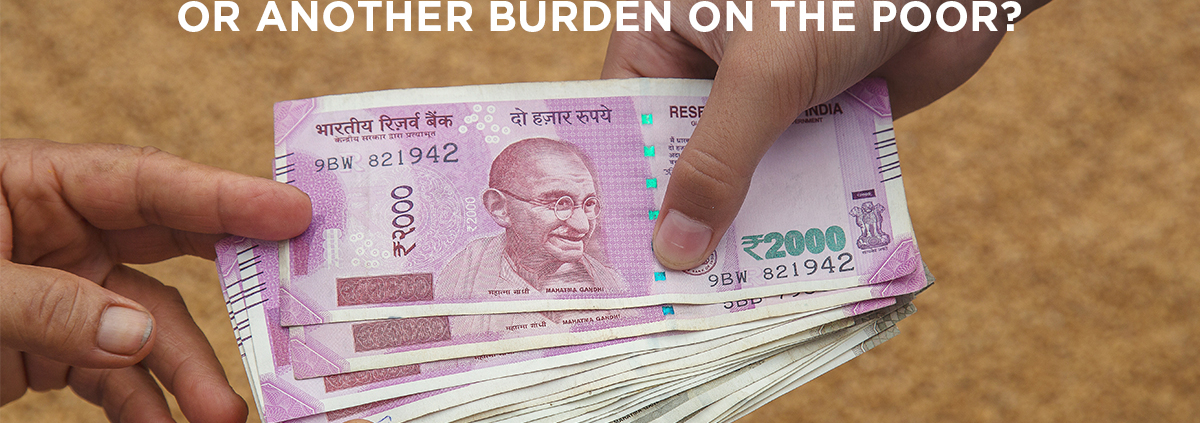Five kgs of one cereal a month per person and one kg of preferred pulse a month per family, free of cost for two months, is the incumbent Indian government’s direct relief plan for 80 million impoverished citizens affected by COVID-19 pandemic. Other cooking ingredients and essentials have to be procured through existing subsidized PDS under the National Food Security Act. The direct grocery disbursement plan will cost the government $460 million, which, according to Prem Shankar Jha – a celebrated Indian Economist – accounts for 0.175% of the whopping $266 billion economic stimulus package announced by PM Modi recently.
After reading between the lines, I understand that the grocery plan is the only action that addresses the immediate plight of impoverished citizens. What happens to the rest of the mega billions? Who is it aimed at? Does it address short- or long-term repercussions of the pandemic?
The devil in the details
The first tranche of the $266 billion, amounting to $22.5 billion, was already announced in March. And around $68.8 billion was intended to be disbursed as loans by the Reserve Bank, but it failed to find takers, despite a decade-low borrowing rate. Commercial banks have no choice but to await borrowers, while the money sits in RBI’s reverse repo account. The remaining billions are earmarked for credit guarantees, loans, liquidity and fiscal support. Such a hit-or-miss attempt at wooing manufacturers to procure loans is liable to fall flat. Even the equity markets witnessed a sharp but short-lived impact, while the messaging for the poor was lost in translation.
The government went as far as redefining what constitutes MSMEs, to bring more manufacturers into the loan-eligibility pool. This, I believe, will definitely invigorate MSMEs in the long term. But what about the health sector, or corporates, or infrastructure? A major chunk of the package is indirect spending by the government, through commercial banks. Although I understand the long-standing buffer problem in banks, this was not the time to fix it. The government is carrying out liquidity reforms, for the long haul, instead of doling out cash directly to people who constitute the demand side. In my opinion this could well be a case of misplaced priorities.
For instance, as per the package, street vendors are eligible for loans amounting to $132. But the reality is that these vendors are mostly oblivious to the loan procurement process, and even the issuing banks have not actively transacted with this group until now. The lockdown and social-distancing guidelines in effect only makes these problems worse.
The paradox of thrift
The government should have prioritized enhancing the purchasing power, through direct economic relief, to keep the demand side healthy. I believe this time-tested policy works best during economic recessions, especially for a country that boasts high aggregate demand like India. This was not an opportune time for being “atmanirbhar”. Long-term self-reliance is actionable during steady economic cycles, not during unprecedented public health crisis.
India’s economy is largely unorganized, with 80% informal workforce, lacking health benefits, job security and retirement packages, contributing to nearly half the GDP. When blue-collar workers can fend for themselves, the economy stays afloat. Today, during the pandemic, they are without work, some of which they may never recover, in the post-COVID world. On the other hand, the rich and the middle class are cutting corners, going frugal and holding back on major investments like buying a house or a car. Where does this leave an under-contract mechanic working for an automobile company that hasn’t witnessed a sale in two months? The same automobile company cannot afford to take loans from banks to finance production, due to their inability to sell the product. So, the mechanic is laid off.
Unlike a mechanic, it is a whole different ball game for a farmer, who takes loans to invest in each crop cycle. Farmer suicide rates have never seen a substantial decline in the past decade, yet the stimulus package was accompanied by radical overhaul of agricultural produce trade. Under the new set of rules, big traders with deep pockets may be able to monopolize the market, determining both the price and the supply.
Essentially, my concern with the package is not about its long-term outlook, but for the lack of its short-term measures. As I see it, loan availability, with or without collateral, does not take precedence over a raging public health crisis. The healthcare sector has been experiencing acute shortage of infrastructure, which, if the COVID-19 cases continue to soar, could lead to disaster. Private hospitals that make up two-thirds of bed capacity are handling merely 10-15% percent of COVID cases. Such flaws have gone largely unacknowledged in the package. Public health spending has been hovering around 1.15% of the GDP since a decade, without redressal from the government. If the greatest public health crisis in modern history cannot change that, I don’t know what will.
All in all, this stimulus package is aimed at long-term reforms, without a sense of urgency, thereby limiting its effect on the current crisis. I believe a much-needed “stimulus” would have been more appropriate in being directed towards the public health sector and demand-side economics. Instead, the government has taken a long-term view and backed measures it hopes will secure a general economic trajectory from too much damage. One is left to wonder if more should have been done to address the basic sustenance of the most vulnerable sections of society. After all, the primary concern of a government should be citizens, not the cogs of the economic machine.



